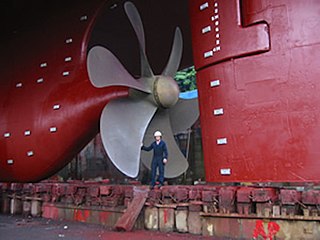
A propeller is a device with a rotating hub and radiating blades that are set at a pitch to form a helical spiral, that, when rotated, exerts linear thrust upon a working fluid, such as water or air. Propellers are used to pump fluid through a pipe or duct, or to create thrust to propel a boat through water or an aircraft through air. The blades are specially shaped so that their rotational motion through the fluid causes a pressure difference between the two surfaces of the blade by Bernoulli's principle which exerts force on the fluid. Most marine propellers are screw propellers with helical blades rotating on a propeller shaft with an approximately horizontal axis.

The router is a power tool with a flat base and a rotating blade extending past the base. The spindle may be driven by an electric motor or by a pneumatic motor. It routs an area in hard material, such as wood or plastic. Routers are used most often in woodworking, especially cabinetry. They may be handheld or affixed to router tables. Some woodworkers consider the router one of the most versatile power tools.
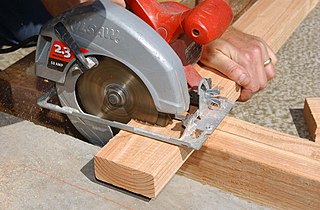
A circular saw is a power-saw using a toothed or abrasive disc or blade to cut different materials using a rotary motion spinning around an arbor. A hole saw and ring saw also use a rotary motion but are different from a circular saw. Circular saws may also be loosely used for the blade itself. Circular saws were invented in the late 18th century and were in common use in sawmills in the United States by the middle of the 19th century.

A tractor is an engineering vehicle specifically designed to deliver a high tractive effort at slow speeds, for the purposes of hauling a trailer or machinery such as that used in agriculture, mining or construction. Most commonly, the term is used to describe a farm vehicle that provides the power and traction to mechanize agricultural tasks, especially tillage, but nowadays a great variety of tasks. Agricultural implements may be towed behind or mounted on the tractor, and the tractor may also provide a source of power if the implement is mechanised.
A saw is a tool consisting of a tough blade, wire, or chain with a hard toothed edge. It is used to cut through material, very often wood though sometimes metal or stone. The cut is made by placing the toothed edge against the material and moving it forcefully forth and less forcefully back or continuously forward. This force may be applied by hand, or powered by steam, water, electricity or other power source. An abrasive saw has a powered circular blade designed to cut through metal or ceramic.
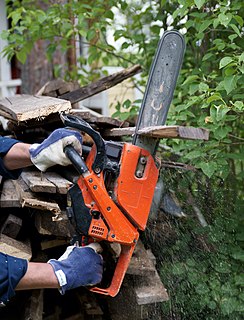
A chainsaw is a portable gasoline-, electric-, or battery-powered saw that cuts with a set of teeth attached to a rotating chain driven along a guide bar. It is used in activities such as tree felling, limbing, bucking, pruning, cutting firebreaks in wildland fire suppression, and harvesting of firewood. Chainsaws with specially designed bar-and-chain combinations have been developed as tools for use in chainsaw art and chainsaw mills. Specialized chainsaws are used for cutting concrete during construction developments. Chainsaws are sometimes used for cutting ice; for example, ice sculpture and winter swimming in Finland.

A winch is a mechanical device that is used to pull in or let out or otherwise adjust the tension of a rope or wire rope.

A lawn mower is a machine utilizing one or more revolving blades to cut a grass surface to an even height. The height of the cut grass may be fixed by the design of the mower, but generally is adjustable by the operator, typically by a single master lever, or by a lever or nut and bolt on each of the machine's wheels. The blades may be powered by manual force, with wheels mechanically connected to the cutting blades so that when the mower is pushed forward, the blades spin or the machine may have a battery-powered or plug-in electric motor. The most common self-contained power source for lawn mowers is a small internal combustion engine. Smaller mowers often lack any form of propulsion, requiring human power to move over a surface; "walk-behind" mowers are self-propelled, requiring a human only to walk behind and guide them. Larger lawn mowers are usually either self-propelled "walk-behind" types or more often, are "ride-on" mowers, equipped so the operator can ride on the mower and control it. A robotic lawn mower is designed to operate either entirely on its own or less commonly by an operator by remote control.

A sawmill or lumber mill is a facility where logs are cut into lumber. Modern sawmills use a motorized saw to cut logs lengthwise to make long pieces, and crosswise to length depending on standard or custom sizes. The "portable" sawmill is of simple operation. The log lies flat on a steel bed, and the motorized saw cuts the log horizontally along the length of the bed, by the operator manually pushing the saw. The most basic kind of sawmill consists of a chainsaw and a customized jig, with similar horizontal operation.

A string trimmer, also called a weed eater, weed whacker, weedwacker, weed whip, line trimmer, brush cutter, whipper snipper or strimmer, is a garden tool for cutting grass, small weeds, and groundcover. It uses a whirling monofilament line instead of a blade, which protrudes from a rotating spindle at the end of a long shaft topped by a gasoline engine or electric motor.

A transmission is a machine in a power transmission system, which provides controlled application of power. Often the term 5-speed transmission refers simply to the gearbox, that uses gears and gear trains to provide speed and torque block conversions from a rotating power source to another device.
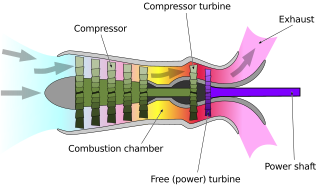
A turboshaft engine is a form of gas turbine that is optimized to produce shaftpower rather than jet thrust. In concept, turboshaft engines are very similar to turbojets, with additional turbine expansion to extract heat energy from the exhaust and convert it into output shaft power. They are even more similar to turboprops, with only minor differences, and a single engine is often sold in both forms.

An agricultural aircraft is an aircraft that has been built or converted for agricultural use – usually aerial application of pesticides or fertilizer ; in these roles they are referred to as "crop dusters" or "top dressers". Agricultural aircraft are also used for hydroseeding.

An overhead power line is a structure used in electric power transmission and distribution to transmit electrical energy across large distances. It consists of one or more uninsulated electrical cables suspended by towers or poles.
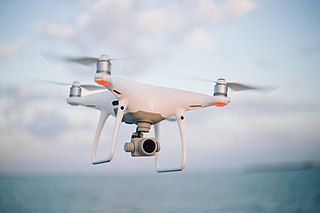
A quadcopter or quadrotor is a type of helicopter with four rotors.

A helicopter is a type of rotorcraft in which lift and thrust are supplied by horizontally-spinning rotors. This allows the helicopter to take off and land vertically, to hover, and to fly forward, backward and laterally. These attributes allow helicopters to be used in congested or isolated areas where fixed-wing aircraft and many forms of VTOL aircraft cannot perform.

The Bratukhin Omega was an early Soviet helicopter, the first product of a new Soviet design bureau, OKB-3 that was created from within TsAGI specifically to develop rotary-wing aircraft. Bratukhin's design was a side-by-side twin rotor machine, with each rotor carried on a long outrigger truss. The Omega's rotors were each powered by a separate engine carried in a nacelle also at the end of the truss. Captive trials commenced in August 1941 and revealed severe problems with engine vibration and overheating. Before these could be addressed, however, OKB-3 was evacuated ahead of the German advance into the Soviet Union.

A cargo hook is a device suspended below a helicopter and allows the transport of external loads during flight. Common terms for this operation include slingwork, underslung loads, external loadwork, and external load operations.
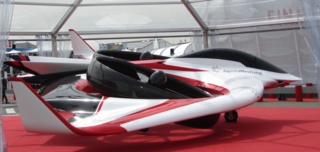
The AgustaWestland Project Zero is a hybrid tiltrotor/Lift fan aircraft. It has been developed by AgustaWestland as a technology demonstrator, and is used to investigate all-electric propulsion and other advanced technologies. It is the world's first electric tiltrotor aircraft.
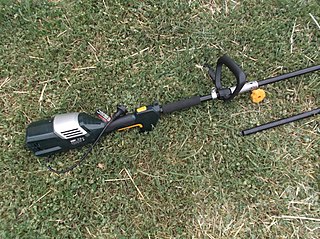
A brushcutter is a powered garden or agricultural tool used to trim weeds, small trees, and other foliage not accessible by a lawn mower or rotary mower. Various blades or trimmer heads can be attached to the machine for specific applications.



















